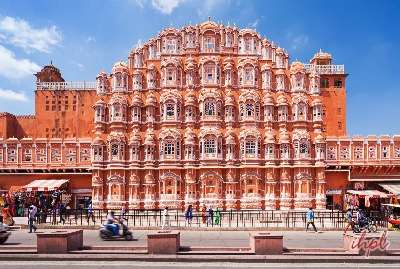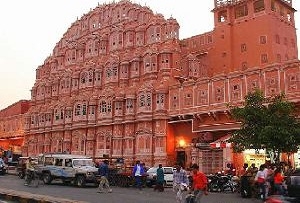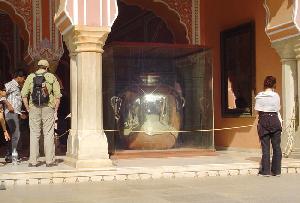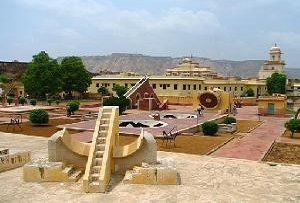Here is a Complete Guide to the City Palace in Jaipur, including information about the palace’s location, attractions, history, timing, and entry fee.
City Palace Jaipur History
Sawai Jai Singh of the Kachwaha Rajput clan built the City Palace. In the 17th century, when it was being constructed, he used it as a residence. He wanted Jaipur to become the capital of Rajasthan instead of Amber. The design of the City Palace in Jaipur was laid out by the architects – Vidhyadhar Bhattacharya and Samuel Swinton Jacob. That is why you can see a European touch to the palace. Raja Man Singh II was the last king of the Kachwaha Dynasty who sat on the throne for the last time.Architecture of City Palace
The City Palace in Jaipur showcases a marvellous blend of Rajput, Mughal, and European architecture. Built according to the principles of ‘Vastu Shastra’ and designed in a grid pattern, the palace has four gates for entry and exit: Tripolia Gate, Udai Pol, Virendra Pol, and Jaleb Chowk. City Palace features numerous palaces, temples, terraces, balconies, gardens, courtyards, and patios, all adorned with intricate latticework, jali work, inlaid ornaments, and carved marble. One of the most captivating parts of the City Palace is Pritam Niwas Chowk, which has four gates, each representing a different season. These remarkable features make the City Palace of Jaipur a true architectural marvel left behind by history. Ready to plan your Jaipur itinerary? Start by exploring the top Tourist Places in Jaipur.City Palace Location
The City Palace is located on Jaleb Chowk, opposite Jantar Mantar. Address: Gangori Bazaar, J.D.A. Market, Pink City, Jaipur, Rajasthan 302002City Palace Timings
The city palace is open from 9:30 a.m. to 6:00 p.m. (day) and 6:30 p.m. to 8:00 p.m. (night). Palace opening and closing times can vary according to the season; check the official website before visiting. Want more than just palaces? Jaipur has thrilling adventures, from hot air balloons to zip-lining.City Palace Entry Fee
The palace is separated into the museum and the royal family residence. Therefore, you need to buy two separate tickets to explore each section. You can also take a combined ticket to visit both parts. Here are the entry charges to City Palace for Indian Nationals –| Indian National/ Resident (All Prices In Indian Rupees) | |||||
| Museum | Composite | Museum Night | Royal Grandeur | Royal Splendour | |
| Included | All Palace Courts & Galleries Still and small video camera without tripod | All Palace Courts & Galleries Jaigarh Royal Cenotaphs Still and small video camera without tripod | Sculpture Lumiere All Palace Courts Selected Galleries Still and small video camera without tripod | Shobha Niwas , Pritam Niwas & Sarvato Roof. | Sri Niwas, Chavi Niwas, Shobha Niwas, Pritam Niwas & Sarvato Roof. |
| Adult | 300 | 400 | 500 | 1500 | 3000 |
| Child (5-12 years) | 150 | 250 | 250 | 1000 | 1500 |
| Senior citizen/ Defence | 150 | 250 | 380 | NA | NA |
| Foreign National/ Resident (All Prices In Indian Rupees) | ||||
| Composite | Museum Night | Royal Grandeur | Royal Splendour | |
| Included | All Palace Courts & Galleries Jaigarh Royal Cenotaphs Still and small video camera without tripod | Sculpture Lumiere All Palace Courts Selected Galleries Still and small video camera without tripod, Audio guide, discount at Baradari Restaurant | Shobha Niwas , Pritam Niwas & Sarvato Roof. | Sri Niwas, Chavi Niwas, Shobha Niwas, Pritam Niwas & Sarvato Roof. |
| Adult | 700 | 1000 | 2000 | 4000 |
| Child (5-12 years) | 400 | 500 | 1500 | 2000 |
| Senior Citizen | 400 | 500 | NA | NA |
Attractions at the City Palace
Many courtyards are inside the City Palace, and a temple is dedicated to Lord Krishna. Here is what is inside the City Palace in Jaipur –The decorated gates of City Palace
This magnificent palace has four entrances: Tripolia Gate, Virendra Pol, Jalebi Chowk and Udai Pol. The main palace has four small gates, Pritam Niwas Chowk, which leads to the Chandra Mahal. People believe that these gates represent the four Hindu gods: Lord Vishnu, Lord Shiva, Goddess Parvati, and Lord Ganesha. There is a Mor Gate to symbolize autumn, a Lotus Gate to represent summer, and a Leheriya Gate to represent spring. Last but not least, the Rose Gate is decorated with rose carvings and symbolizes the winter season.Mubarak Mahal
Welcome Palace, or Mubarak Mahal, is built with a European touch. It has been converted into the Maharaja Sawai Mansingh Museum and showcases a collection of robes, Pashmina shawls, and Sanganeri block-print clothes.Entrance Gates
The City Palace has several grand gates, including Tripolia Gate, Virendra Pol, and Udai Pol. Each gate of this royal complex combines Rajput and Mughal architectural styles. Ready to embark on a Jaipur adventure? Discover our Jaipur Packages and start planning your dream trip todayChandra Mahal
A grand peacock gate welcomes you to Chandra Mahal. This palace is known for its beautiful paintings and mirror embellishments that fascinate tourists. It is a seven-floored building with each given a different name – Sukh-Niwas, Mukut Mahal, Ranga Mandir, Pitam Niwas, Shri-Niwas, and Chhavi-Niwas (in no particular order). The kings used the Chhavi Niwas as their monsoon retreat. The ticket for Chandra Mahal has to be bought separately.Pritam Niwas Chowk
The chowk features four smaller gates, each representing a different Hindu deity and a different season. As you enter the majestic Chandra Mahal, you can see a glimpse of Jaipur’s royal lifestyle.Armory
Known as Anand Mahal Sileh Khana in earlier times, the armoury has an extensive collection of weapons used by Rajputs in wars. It includes daggers, rifles, knuckle braces, and more. Some of the weapons displayed in the armoury are from the 15th century. Sukh Niwas The complex contains a Sukh Niwas, also called the Hall of Rest, where the royal family have their dinner. You can see a variety of paintings and crystals here, including Lalique’s famous crystal dining table. Stunning craftsmanship reflects the luxury of the royal family on this table.Baaghi Khana
This part of the City Palace has many royal rides and chariots that the royal family uses. The royal chariot was built in European style and was gifted by Queen Victoria in 1876 to Maharaja Sawai Ram Singh II.Maharani Palace
The Maharani Palace was the residence of the queens of Jaipur. Its intricate designs and spacious rooms highlight the luxurious lifestyle of the royal ladies. The architecture is elegant and functional, providing comfort and privacy. Looking for essential information on Jaipur? Our Jaipur Guide is your go-to resource.Shobha Niwas
The stunning gold embellishments and intricate mirror work in Shobha Niwas make it a spectacular place to visit. In this room, hand-painted ceilings and ornate decorations reflect regal splendour, offering visitors a glimpse into the royal lifestyle of Jaipur.Rajendra Pol
The Rajendra Pol is another entrance to the City Palace. It connects different sections throughout the palace and exhibits intricate architectural details typical of Rajasthani palaces.The Clock Tower
City Palace’s clock tower is a historical landmark that signifies the keeping of time in royal Jaipur. Visitors can appreciate its historical significance and architectural beauty amid bustling markets.Diwan-e-Khaas
Diwan-e-Khaas is a royal darbar that houses life-size paintings of the Jaipur Maharajas. The Maharaja used to hold private meetings with his courtiers at this place. The royal throne, called ‘Takht-e-Rawal,’ along with chairs, can be seen in this hall, which has beautiful gold and red ceilings. The paintings on the walls also contain ancient texts, embroidered rugs, and handwritten original manuscripts of Hindu scriptures. Are you interested in learning more about other fascinating monuments in Jaipur? Check out our comprehensive guide.Peacock Gate
Another city palace attraction that attracts visitors’ attention is the Peacock Gate, which has a stunning peacock motif. It is a popular spot for photography because of its vibrant colours and intricate carvings, making it one of the complex’s most admired entrances.Diwan-e-Aam (Sarvato Bhadra)
This is the first palace you will see when you enter the City Palace. It was used to hold meetings with the common public of Jaipur. The architecture of this hall is worth seeing. The magnificent crystal chandeliers hanging from the ceiling and two gigantic silver urns are present here. Legend says that Maharaja Sawai Madho Singh II used these vessels to carry water from the holy river Ganges to England. Besides, the marble flooring and stalls where you can shop traditional Rajasthani dresses and handicrafts are not to be missed.Govind Dev Ji Temple
This temple in City Palace is dedicated to Lord Krishna. It receives a large number of devotees every day and is thronged by people during the Janmashtami festival.Rang Mandir
It is also known as the Hall of Color, known for its stunning mirror work on walls and ceilings. This area was used for royal celebrations and performances, showcasing vibrant colours that created an enchanting atmosphere for visitors.Nearby Attractions
There are many monuments and attractions near city places such as:- Jantar Mantar (100m – 3 min)
- Hawa Mahal (650m – 6 min)
- Albert Hall Museum (3.1km – 11min)
- Jal Mahal (4.9km – 16 min)
- Birla Mandir (4.8km – 16min)
Traveller Tips
Here are some things you must keep in mind while visiting City Palace in Jaipur –- The place is fit for differently-abled people.
- Hire a local guide in the local language. You can also take an audio-guide tour.
- Wear comfortable shoes.
- You can shop for locally produced paintings and jewellery from the museums.
- Carry a water bottle.
- The palace tour will require 2 to 3 hours.
- There are certain places where you cannot click pictures.
- Visit City Palace between September and March as the weather is pleasant.












